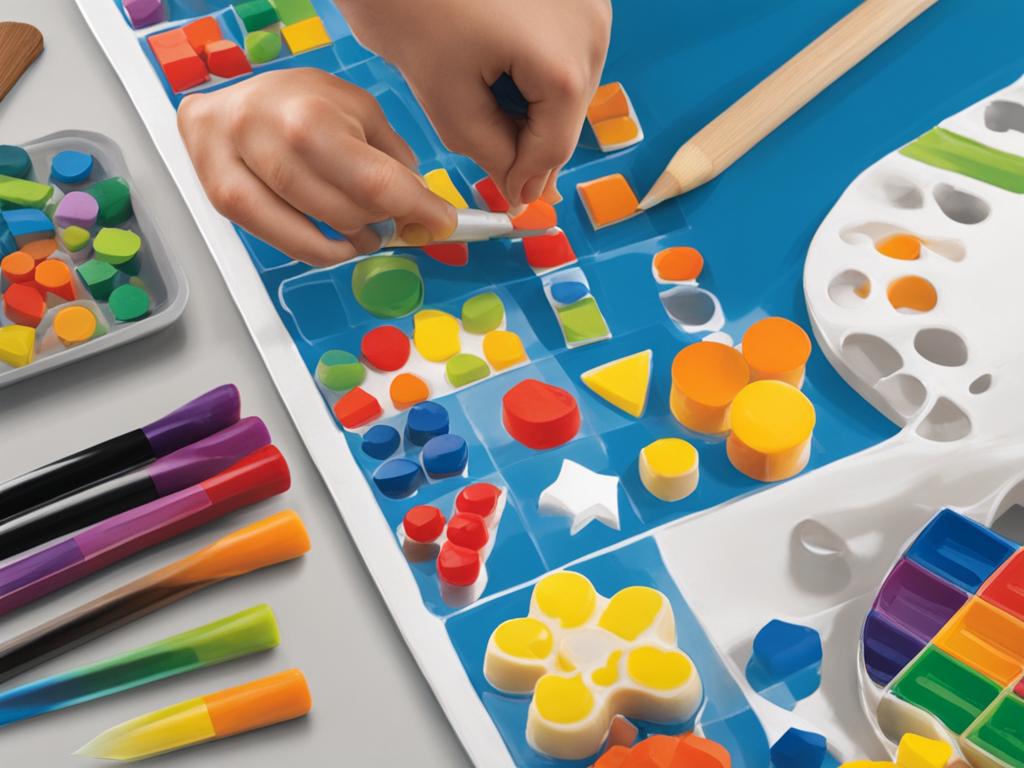Master Communication with Our Expanding Expression Tool
Enhancing communication skills is essential for personal and professional success. The Expanding Expression Tool (EET) is a versatile language development tool designed to improve oral and written expression. Developed by Sara L. Smith, a renowned speech-language pathologist, the EET has proven to be highly effective in various educational settings.
With the EET, students can enhance their vocabulary comprehension, define and describe objects more effectively, categorize information, and make associations. This tactile tool provides a structured framework for language development, empowering students to become confident and proficient communicators.
Whether you are a teacher, parent, or speech-language professional, the Expanding Expression Tool is a valuable resource for improving communication skills. Its multi-functional approach and proven results make it an indispensable tool in the field of language development.
Key Takeaways:
- The Expanding Expression Tool (EET) enhances oral and written expression.
- Developed by Sara L. Smith, a speech-language pathologist, the EET has proven effectiveness in various educational settings.
- The EET improves vocabulary comprehension, defining/describing skills, categorization, and associations.
- This tactile tool provides a structured framework for language development.
- The EET is a valuable resource for educators, parents, and speech-language professionals.
The Development of the Expanding Expression Tool
Sara L. Smith, the creator of the Expanding Expression Tool, developed it after noticing the difficulties children face in expressing themselves. She designed the tool to help students provide more details when describing objects and found that it had immediate and remarkable results in improving their communication skills. The EET was initially introduced in classrooms and has now expanded to over 4,000 classrooms in 22 states.
The Expanding Expression Tool was born out of Sara L. Smith’s deep understanding of language processing and the challenges faced by students in their oral and written expression. Through extensive research and hands-on experience, Smith recognized the need for a tool that would empower students to effectively communicate their thoughts and ideas. By equipping them with the necessary skills, she aimed to enhance their language development and ultimately improve their overall communication abilities.
Since its introduction, the Expanding Expression Tool has garnered widespread recognition and adoption in educational settings. It has become an indispensable resource for teachers and speech-language pathologists alike, with its efficacy in supporting language and writing skills showcased in over 4,000 classrooms across 22 states. Sara L. Smith’s innovative tool has proven to be a game-changer, revolutionizing the way students approach and engage in communication.
The development of the Expanding Expression Tool by Sara L. Smith has had a profound impact on the field of communication and language development. By providing students with the necessary framework and strategies to express themselves effectively, the tool has become a catalyst for improved oral and written expression. As the Expanding Expression Tool continues to expand its reach, it is poised to transform the way educators approach communication instruction, enabling students to unlock their full potential.
The Expanding Expression Tool: A Tactile Tool for Language and Writing Development
The Expanding Expression Tool (EET) is a versatile tool developed by a speech-language pathologist to enhance both oral and written expression. This tactile tool incorporates a color-coded chart that helps students describe objects by focusing on their group, function, appearance, composition, parts, location, and additional knowledge. By using the EET, students can develop their language and writing skills in a structured and organized way.
The EET is designed to support students in expanding their vocabulary, improving their ability to describe objects, and making connections between different aspects of language. It provides a framework that can be used for various purposes, such as enhancing descriptive writing, personal narratives, informative writing, and opinion writing. With the EET, students can learn to include more details in their writing and develop a deeper understanding of language expression.
“The Expanding Expression Tool has been a game-changer in my classroom. It has helped my students become more confident in their oral and written expression. The color-coded chart provides a visual guide for them to organize their thoughts and expand their vocabulary. I have seen remarkable improvements in their language and writing skills since implementing the EET.”
Teachers can introduce the EET at different grade levels and adapt it to meet the specific needs of their students. In preschool and kindergarten, the tool can be integrated into regular curriculum studies and used to support early writing and vocabulary expansion. In higher-grade levels, the focus can shift more towards writing, with the EET providing visual prompts and strategies to enhance language expression. Ultimately, the EET can be modified to meet the needs of students and support their language and writing development at every stage of their education.
Overall, the Expanding Expression Tool is a valuable resource for educators and speech-language professionals looking to enhance communication skills. Its tactile nature and color-coded chart make it engaging for students, while its structured framework provides a systematic approach to language and writing development. With the EET, students can improve their oral and written expression, expand their vocabulary, and become more confident communicators.

Benefits of the Expanding Expression Tool
The Expanding Expression Tool (EET) offers numerous benefits for struggling or reluctant writers, as well as for students of different ages and abilities. By providing a structured approach to language and writing development, the EET helps students expand their vocabulary and improve their ability to describe objects in an organized way.
One of the key advantages of the EET is its ability to support differentiated instruction. Teachers can adapt the tool to meet the specific needs of each student, whether they require additional support or challenges. This flexibility allows educators to effectively target individual students’ language and writing enhancement goals, ensuring that each student receives the appropriate level of instruction.
The EET’s structured framework also helps students overcome writer’s block and organize their thoughts. By guiding them through the process of describing objects using different categories, the tool encourages critical thinking and fosters creativity. Students learn to categorize, make connections, describe appearance and function, identify parts, and provide additional information, which ultimately improves their overall language and writing skills.
Moreover, the EET can be used in various instructional settings. It can be employed in one-on-one sessions, small groups, or even in whole-class instruction, making it a versatile resource for educators. By incorporating the tool into their teaching strategies, educators can create a supportive learning environment that promotes active participation, engagement, and collaboration among students.
Table: Advantages of the Expanding Expression Tool
| Advantages | Description |
|---|---|
| Enhanced Language and Writing Skills | The EET helps students expand their vocabulary and improve their ability to describe objects in an organized way, leading to enhanced language and writing skills. |
| Support for Differentiated Instruction | The EET can be adapted to meet the specific needs of each student, allowing teachers to provide personalized instruction and support. |
| Improved Critical Thinking and Creativity | By guiding students through the process of describing objects using different categories, the EET encourages critical thinking and fosters creativity. |
| Versatile Application | The EET can be used in various instructional settings, such as one-on-one sessions, small groups, and whole-class instruction. |
In conclusion, the Expanding Expression Tool offers a range of benefits for struggling and reluctant writers, as well as for students at different grade levels. Its structured approach to language and writing development helps students expand their vocabulary, organize their thoughts, and improve their overall communication skills. With its flexibility and versatility, the EET proves to be a valuable resource for educators seeking to enhance language and writing instruction in their classrooms.
How to Use the Expanding Expression Tool
The Expanding Expression Tool (EET) is a versatile resource that can be used to enhance various types of writing, including descriptive writing, personal narratives, informative writing, and opinion writing. By incorporating the different components of the tool, students can learn to include more details in their writing, making their compositions more engaging and impactful.
When using the EET for descriptive writing, students can utilize the color-coded chart to describe the appearance and function of objects. They can also categorize items based on their group and identify the different parts that make up an object. This helps students paint a vivid picture with their words and create a clear image in the reader’s mind.
In personal narratives, the EET can be used to guide students in recounting their experiences with greater detail. By focusing on the location, additional knowledge, and associations related to their stories, students can add depth and richness to their narratives. This enables them to effectively communicate their thoughts, feelings, and experiences to the reader.
For informative writing, the EET provides a structured framework for presenting information in a clear and organized manner. Students can use the tool to categorize and describe the topic they are writing about, as well as provide additional details and associations. This guides them in presenting factual information in a cohesive and engaging way.

Table: Ways to Use the Expanding Expression Tool in Writing
| Writing Type | Focus | Components of the EET |
|---|---|---|
| Descriptive Writing | Describing appearance and function | Group, Function, Appearance, Parts |
| Personal Narratives | Recounting experiences | Location, Additional Knowledge, Associations |
| Informative Writing | Presenting information | Group, Function, Additional Knowledge, Associations |
| Opinion Writing | Expressing personal viewpoints | Characteristics, Examples, Conclusions |
In opinion writing, the EET can help students express their personal viewpoints in a structured and convincing manner. By focusing on the characteristics of the topic, providing examples, and drawing conclusions, students can effectively communicate their opinions and support their arguments.
Overall, the Expanding Expression Tool serves as a valuable tool for enhancing writing skills across different genres. By incorporating the various components of the EET, students can improve their descriptive abilities, add depth to their narratives, present information effectively, and express their opinions with clarity and conviction.
Applying the Expanding Expression Tool in Different Grade Levels
The Expanding Expression Tool (EET) is a versatile resource that can be introduced at various grade levels to support language and writing development. Let’s explore how the EET can be applied in preschool, kindergarten, first grade, and higher-level writing.
The EET in Preschool
In preschool settings, the EET can be integrated into regular curriculum studies to enhance language development. Teachers can incorporate the tool into activities such as shared writing, where students can collaboratively describe objects using the EET’s color-coded chart. By introducing the tool at this early stage, preschoolers can start building their vocabulary and developing an understanding of describing objects in an organized way.
The EET in Kindergarten
Kindergarten is a crucial stage for early writing and vocabulary expansion. The EET can be used throughout the day, in various subjects, to support students’ language and writing development. Teachers can provide visual prompts and strategies to help kindergarteners incorporate more details into their writing. By utilizing the EET, students can become more confident in expressing themselves and develop stronger language skills.
The EET in First Grade and Beyond
In first grade and higher-level writing, the focus can shift more towards using the EET as a tool for enhancing language expression. Teachers can provide students with opportunities to practice descriptive writing, personal narratives, informative writing, and opinion writing using the different parts of the EET. By gradually introducing and expanding upon the tool, students can further enhance their language expression and writing skills.
Using the Expanding Expression Tool in Classroom Settings
The Expanding Expression Tool (EET) can be effectively utilized in both therapy sessions and classroom settings to enhance language and writing development. This versatile tool offers various strategies and techniques that can benefit students in full group lessons, allowing for comprehensive literacy and improved language expression.
Push-in Therapy
One way to utilize the EET is through push-in therapy, where speech-language pathologists work directly in the classroom setting. By using the tool, therapists can support students’ language and writing development in real-time, providing immediate feedback and guidance. This approach allows for a more cohesive and inclusive learning environment, where students can receive targeted support while participating in full group lessons.
Comprehensive Literacy
Integrating the EET into classroom instruction can enhance comprehensive literacy. Teachers can introduce the tool to the whole class, providing language expression strategies that benefit all students. By using the EET, students can learn to expand their vocabulary, organize their thoughts, and describe objects in a more detailed and structured manner. This not only improves their writing skills but also enhances their overall communication abilities.
Language Expression Strategies
The EET provides teachers with effective language expression strategies that can be utilized in full group lessons. By incorporating the tool into daily instruction, teachers can teach students how to categorize, make connections, describe appearance and function, identify parts, and provide additional information. These strategies enable students to develop stronger language expression skills, which in turn enhances their overall academic performance.

| Potential Benefits | Examples |
|---|---|
| Improved language and writing skills | Students will be able to express their thoughts and ideas more effectively. |
| Enhanced participation in full group lessons | Students will be more actively engaged and able to contribute to classroom discussions and activities. |
| Increased confidence in communication | Students will feel more confident expressing themselves both orally and in writing. |
By incorporating the Expanding Expression Tool into classroom settings, educators can create a supportive and inclusive learning environment. Through push-in therapy and comprehensive literacy, students can benefit from the strategies provided by the tool, improving their language expression skills and overall academic performance. The EET offers a practical and effective solution for educators looking to enhance communication skills in their classrooms.
The Expanding Expression Tool – A Simple and Effective Solution
The Expanding Expression Tool (EET) is a powerful resource that adopts a multisensory approach to enhance communication skills. By using a color-coded chart and a tactile tool, it provides students with a structured framework to describe objects and expand their vocabulary. The EET guarantees quick results and can be utilized for various purposes, including object descriptions and vocabulary comprehension.
The EET’s multisensory approach engages students through visual and tactile experiences, making it easier for them to understand and remember information. As students use the tool to describe objects based on their group, function, appearance, composition, parts, location, and additional knowledge, they are encouraged to think critically and make connections, leading to a more comprehensive understanding of the subject matter.
One of the key strengths of the EET is its ability to support students in describing objects accurately and in detail. This not only improves their communication skills but also enhances their ability to express themselves effectively in both oral and written formats. Additionally, the EET fosters vocabulary development by encouraging students to explore different aspects of an object, thereby expanding their word bank and improving their overall language comprehension.
| Benefits of the Expanding Expression Tool | Description |
|---|---|
| Enhanced Communication Skills | The EET provides a structured framework for students to describe objects effectively, improving their overall communication abilities. |
| Improved Vocabulary Comprehension | Using the EET encourages students to explore different aspects of an object, expanding their word bank and enhancing their overall language comprehension. |
| Engaging Multisensory Approach | By incorporating visual and tactile experiences, the EET engages students and makes the learning process more enjoyable and effective. |
By utilizing the Expanding Expression Tool, educators and speech-language professionals can provide their students with a simple and effective solution to improve communication skills. The multisensory approach, quick results, and focus on object descriptions and vocabulary comprehension make the EET a valuable resource for enhancing language development and fostering effective communication.

Conclusion
The Expanding Expression Tool (EET) is a powerful resource that enhances communication skills by providing a structured framework for language and writing development. Whether used in therapy sessions or integrated into classroom instruction, this tactile tool offers effective strategies to enhance communication abilities.
By incorporating the EET into educational settings, educators, parents, and speech-language professionals can support students in expanding their expression and improving their language skills. Its multisensory approach and color-coded chart make it an engaging and impactful tool for enhancing communication.
With its widespread success and positive feedback, the Expanding Expression Tool has become a go-to resource in the field of language development. It serves as an invaluable communication resource, offering language expression strategies that empower students to express themselves more effectively.
FAQ
What is the Expanding Expression Tool?
The Expanding Expression Tool (EET) is a tactile tool developed by a speech-language pathologist to enhance oral and written expression, vocabulary comprehension, defining/describing, categorization, and making associations.
Who created the Expanding Expression Tool?
The Expanding Expression Tool was developed by Sara L. Smith, a speech-language pathologist, after noticing the difficulties children face in expressing themselves.
How does the Expanding Expression Tool work?
The Expanding Expression Tool uses a color-coded chart to help students describe objects by their group, function, appearance, composition, parts, location, and additional knowledge.
Who can benefit from using the Expanding Expression Tool?
The Expanding Expression Tool is particularly beneficial for struggling or reluctant writers, but it can be adapted to meet the needs of students of different ages and abilities.
How can the Expanding Expression Tool be used?
The Expanding Expression Tool can be used for various types of writing, including descriptive writing, personal narratives, informative writing, and opinion writing.
Can the Expanding Expression Tool be used at different grade levels?
Yes, the Expanding Expression Tool can be introduced at different grade levels and tailored to meet specific learning objectives.
Can the Expanding Expression Tool be used in therapy sessions?
Yes, the Expanding Expression Tool can be effectively used in both therapy sessions and classroom settings to support language and writing development.
How can the Expanding Expression Tool enhance communication skills?
The Expanding Expression Tool provides students with a structured framework for describing objects and expanding their vocabulary, ultimately improving their communication abilities.
Is the Expanding Expression Tool widely recognized in the field of language development?
Yes, the Expanding Expression Tool has gained widespread success and positive feedback, making it a go-to resource for language and writing development.

